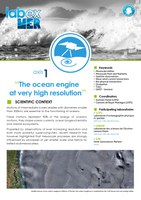Coordinators
Participating laboratories
Scientific context
Motions of intermediate scales (eddies with diameters smaller than 200km) are essential to the functioning of oceans. These motions represent 90% of the energy of oceanic motions, they shape ocean currents, the ocean biogeochemistry and marine ecosystems.
Propelled by observations of ever increasing resolution and ever more powerful supercomputers, recent has however highlighted that mesoscale processes are strongly influenced by processes of yet smaller scale and hence labelled submesoscales.
Scientific concerns
- Study of the 3D dynamics of the oceanic upper 500m.
- Impact of the oceanic circulation between mesoscale and submesoscales on biochemistry and the marine ecosystem.
- Triple interaction between the atmospheric and oceanic circulation and surface gravity waves.
- Dissipation of energy in the deep ocean via interaction or not with topography.
- Interaction between mesoscale/submesoscales and tidal phenomena.
Expected results
- Improved understanding of the oceanic dynamic of mesoscale and submesoscale, on its impact on the circulation at larger scales, on the atmospheric circulation and waves, and on marine ecosystems and biochemistry.
- Development of tools combining observations (satellite, in situ) and numerical models will improve the ability to observe and predict fluctuations of the ocean at these scales.
More information (downloads)
2012-2015 axis 1 roadmap
NEW : 2016-2019 axis 1 roadmap














